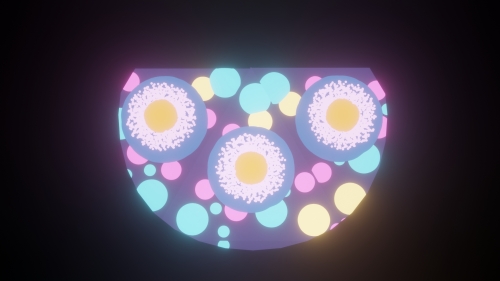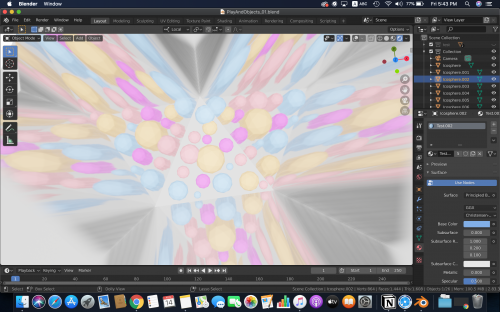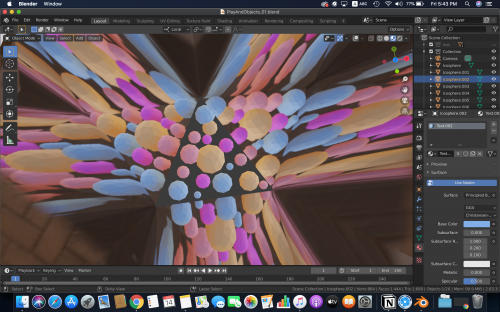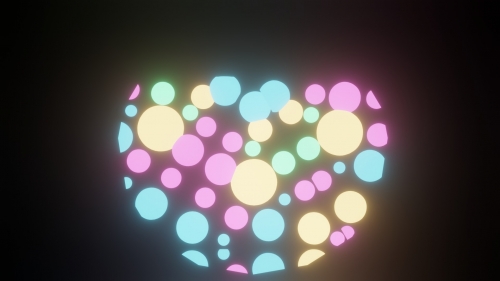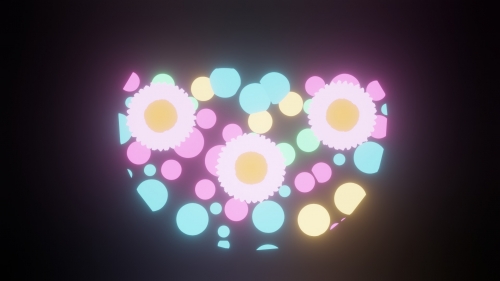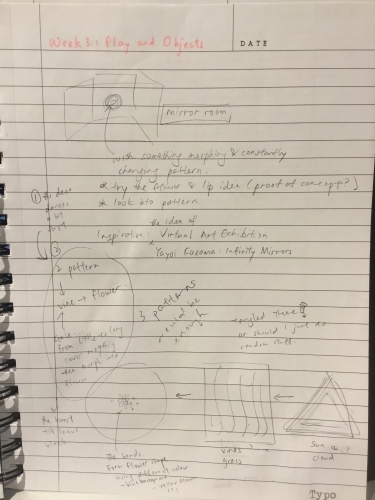Theme
Play and Objects
Context
When I was brainstorming ideas about the topic, I couldn't help but think more about the possibilities of playing with the material of an object. One of the attributes that stands out the most to me is reflection. I still remember the joy of playing with a kaleidoscope when I was a child. The beauty of it is that it's different every time I look through the small-cap. The pattern is so perfectly mirrored and random that one couldn't exactly get the same visual even though one has two identical kaleidoscopes. And the mechanism is so simple that all one needs to do is shake the kaleidoscope. When looking through the small-cap, it's like I'm peeking into a whole new world. The small toy is designed so that we, as children, would be attracted to the simple mechanism and actively seek out information through play (Sutton-Smith 2001).
I was then inspired more by Yayoi Kusama's work of Infinity Mirrors. (https://www.youtube.com/watch?v=8VwJMw_fLvI) It is an art installation that is basically created in a mirror room. The artist used the reflection of the mirror to create a false sense of infinity space. Then, the artist placed different objects into the space to create a variety of patterns in the room. Although that work seems to stress more on the idea of 'space', it provided me with the idea of playing with the reflection of a mirror.
My original idea was to play with the IOR (one of the material attributes) of the mirror and see how it will influence the overall reflection. I even thought about adding random roughness to the surface so that it would affect the final visual. But then I remembered the changing patterns of a kaleidoscope and decided that I would like to explore more on the reflected objects. I would like to know whether a mirrored pattern that is created by a perfect resemblance of the kaleidoscope in 3D space would have a similar effect as a kaleidoscope toy has on me. Would it urge the audience to play the video over and over again? Also, would it be as visually appealing as a kaleidoscope? As for the more technical side of the exploration, I would like to test out how morphing object works in Blender and what the morphing objects would do to the final result.
Method
I was trying to optimise the screen space reflection of Blender before discovering the existence of the amazing reflection plane. Using screen space reflection created a problem of the mirror not reflecting the faces that are not directly showing in the viewport. Unless I'm using Cycles to render, the problem won't be fixed. The thing is rendering with Cycles takes a longer time than the real-time render engine, Eevee. That's why I tried to find a solution to the reflection problem. This is where the reflection plane comes into place. I found out that the reflection plane could simply create the result I wanted using Eevee. The only disadvantage of using it is that it requires a lot of calculating power to do the real-time rendering. Therefore, I was using the shader viewport when animating. I did not get the chance to see how the patterns work with the reflection of the mirror unless I rendered one frame out.
Below are my steps for completing this project.
- Get the mirror reflection working
- Get the morphing function working
- Get the beads on the plane (particle system)
- Change the colour of the beads to form a pattern
- Get the morphing and change of colour work together
- Check it with the mirror
- Playblast
- Final adjustment
- Render
I did not want to make the same mistake I did in the first project, which was noticing the problem of the timing of the animation only after rendering, thus, I searched online for a way to do something equivalent to a Playblast in Maya. Fortunately, I found a method. Although it's not as quick as Playblasting in Maya, it still produced a satisfying result. Through the viewport rendering, I was able to preview the animation without really rendering out the whole thing. It sped things up. I was able to spot a few problems and fix them before rendering. Then I composited them in After Effects.
Response
The final work is kind of like an experimental animation about flowers. It shows the life of the seeds. They grow into a garden, blossom into flowers, and then burst into nothing.
Reflection
Play is not just about the final goal, but also about the journey of the experiment towards the end (Sutton-Smith 2001). I knew I wanted to play with the idea of reflection and wanted to do something with changing patterns happening as an end result. But the number of experiments/ playful exercises/ iterations I was doing in the middle was funny enough for me to be happy even though the final result might not be successful, which luckily, worked out pretty well!
When experimenting with how the morphing works in Blender, I found out about the morphing of particles. It's not necessarily the kind of morphing I was going for at first, but it does work well with the idea of the kaleidoscope as the pattern of a kaleidoscope is indeed formed by the reflection of small objects (beads, small pieces of colour paper, etc.). Therefore, I adopted the idea of particle morphing and started designing what I want the particles to do. By using the method of particle morphing, it opened up tons of possibilities. I thought about the patterns directly transforming from one to another, and also the probability of different layers of particles stacking on one another before transforming. I have no idea of how to create a pattern of particles with specific colour zone, therefore, I dedicated my time to develop on the second idea. It worked and I was so happy. Although there was a time where my expected result was not achieved, trying to branch out from the failure and finding another solution was fun.
Animating without knowing what the final result would be is one of the aspects of play in this project. The other one is my experiment with both the reflection material and the morphing particles. Honestly, I feel like experimenting with the composition mode in Blender next time as well as I never tried it before.
As for the 'objects' aspect of the theme, I had a few methods of approaching. The amount of items I animated in the middle of the mirror setup is definitely qualified as 'objects'. The idea of playing with reflective material is another approach to represent 'objects'. Moreover, the constant moving of particles and their flow present the abstract idea of 'objects'. In my understanding, an object is something that is constantly moving and changing its state depending on the different conditions it is under. It could be an object getting worn out over time or an object literally changes its state from liquid to solid. In this case, each and every particle of my animation performs their individual task of moving in space over a certain period of time. Therefore, the particle that runs wild without having an intention in mind, forms a beautiful pattern in the bigger picture at the end.
Inspiration & Tutorials
Inspiration:
Yayoi Kusama: Infinity Mirrors
https://www.youtube.com/watch?v=8VwJMw_fLvI
Tutorials:
Reflection: https://www.youtube.com/watch?v=aqSOOIsPTrM
Morphing particles: https://www.youtube.com/watch?v=UgmJsLcLXUI
References
Sutton-Smith, B. (2001). The Ambiguity of Play. Harvard: Harvard University Press.
p36-37 of Rhetorics of Child Play, Chapter 3 of 'The Ambiguity of Play'
p197-200 of Rhetorics of Self, Chapter 10 of 'The Ambiguity of Play'
About This Work
By Yee Hui Wong
Email Yee Hui Wong
Published On: 16/08/2020
